HTC Sensation 4G Review - A Sensational Smartphone
by Brian Klug on July 1, 2011 12:38 AM EST- Posted in
- Smartphones
- HTC
- Android
- Mobile
- HTC Sensation
- MSM8260
Performance
I’ve been skirting around it for no real reason, but the obvious other big important feature on the Sensation is that it’s the first dual core 45nm snapdragon SoC we’ve looked at in a shipping device. The HTC Sensation is built around a 1.2 GHz Qualcomm MSM8260 SoC with Adreno 220 graphics and integrated Previously, we looked at 3D performance on a 1.5 GHz Qualcomm MSM8660 in a Mobile Development Platform, and briefly in our initial hands on preview piece at Uplinq. There, we saw that performance was about where it should be given the difference in resolution between what we had tested (WVGA - 800x480) and the Sensation’s qHD (960x540) display.
The elephant in the room is what CPU performance on MSM8x60 is like. Dual core snapdragon consists of two scorpion cores clocked at up to 1.5 GHz. Anand is going to give a much deeper CPU architecture dive when he looks at the MSM8660 inside the EVO 3D (again, the x in MSM8x60 merely denotes which modem is onboard), but for now I’m going to present all the benchmark results for the Sensation.
First up are our web benchmarks, which primarily test JavaScript and page rendering. We’re still running SunSpider 0.9, though we’ll soon switch to 0.9.1 and report that alongside. JavaScript performance on HTC’s browser isn’t as good as it should be, and I’m a bit disappointed here that things aren’t better. We’ve seen HTC’s browser result in lower scores before, but it still is at odds with what Qualcomm has told me about how closely the two collaborate to optimize V8 for scorpion.
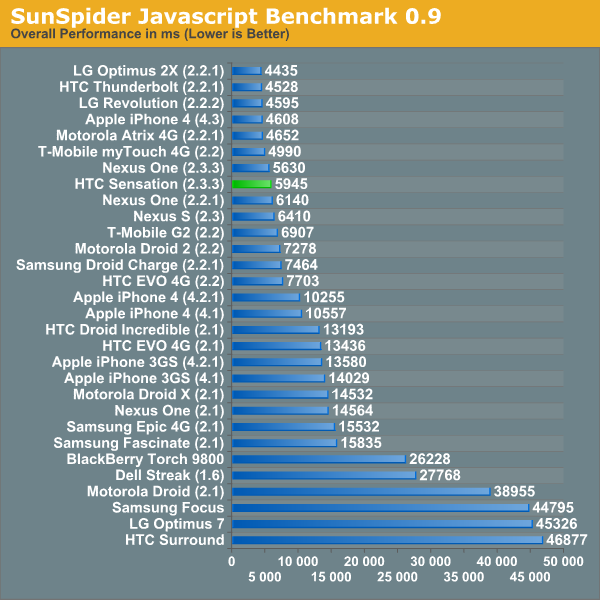
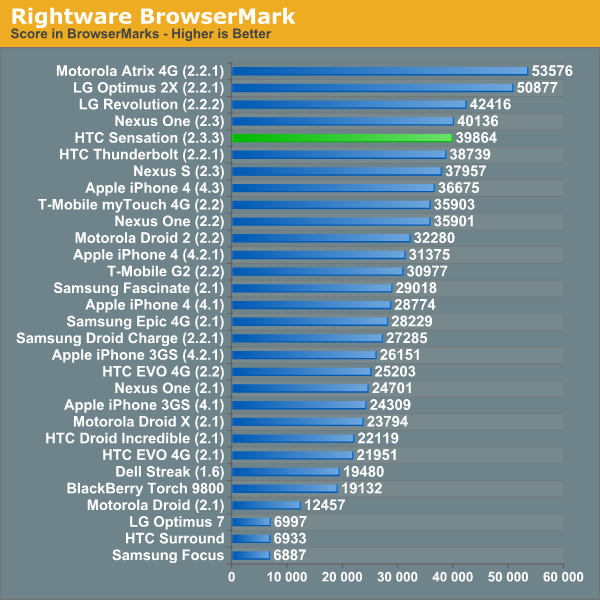
Flash is next, and here the Sensation delivers pretty good performance. It’s hard to make a direct comparison against the Optimus 2X again because we’re dealing with WVGA versus qHD, and we run this test aspect scaled.
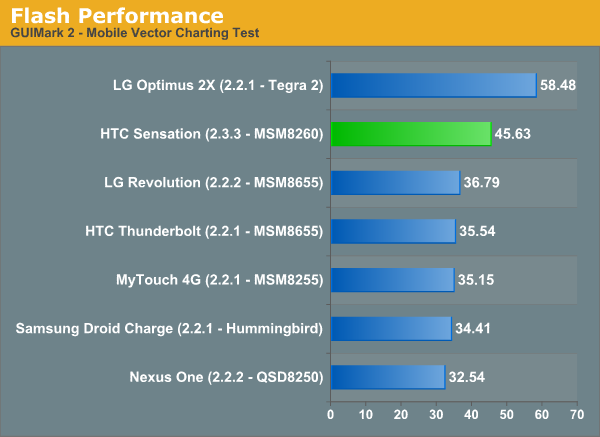
I’m putting Neocore up next because I want to mention again that we’re capped at vsync. We had some hope for a while that we could turn vsync off on handsets, however this is only possible on development hardware, not final ROMs that ship in devices. Odds are you won’t see this pop up again in our suite unless we can make it actually say something. We’re at the Surround’s 60fps wall even at qHD.
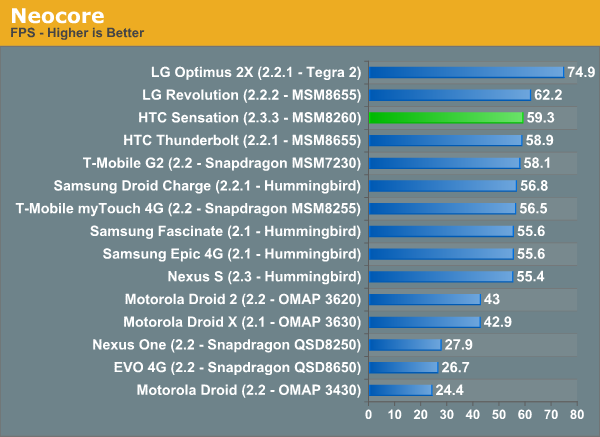
GLBenchmark 2.0 is a mainstay in our benchmarking section, and I’ve already broken down results in our HTC Sensation hands on back at Uplinq. Things have actually improved a bit since that hurried benchmark run over dinner in San Diego, with the Sensation posting around 2fps higher in Egypt and Pro. Again keep in mind the resolution differences between everything here, there’s a 1.35x increase in pixels going from WVGA to qHD.
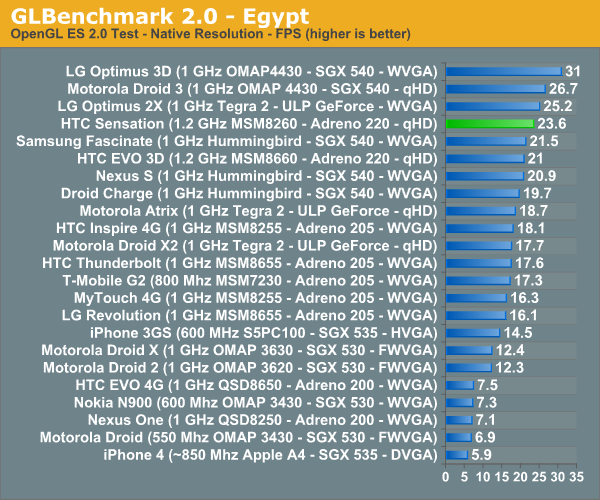
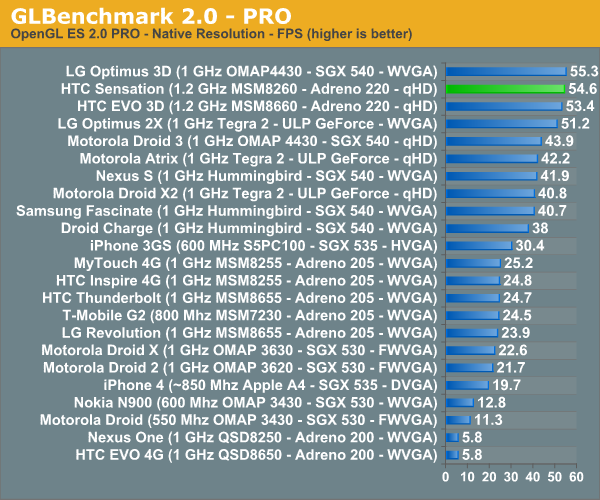
Next is BaseMark ES2.0, which is a nominally updated version of the hugely popular, industry-standard 3DMarkMobile ES2.0. Here we run at the default resolution, which is VGA, and thus get a picture without being constrained to just native resolution constantly. This one is a bit new for us, and I expect that Anand and I are going to explain things a bit more in the EVO 3D story. For now, just take away that MSM8x60 appears very speedy.
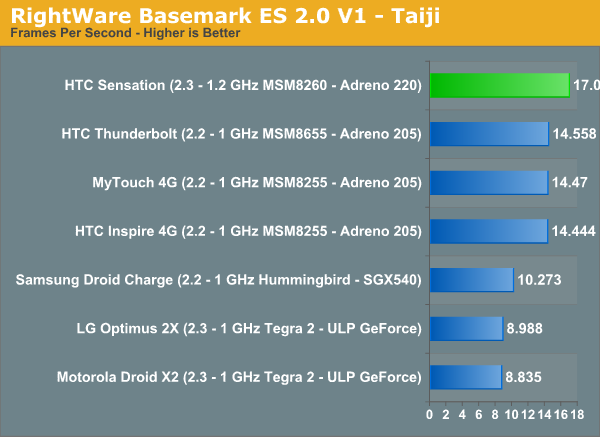
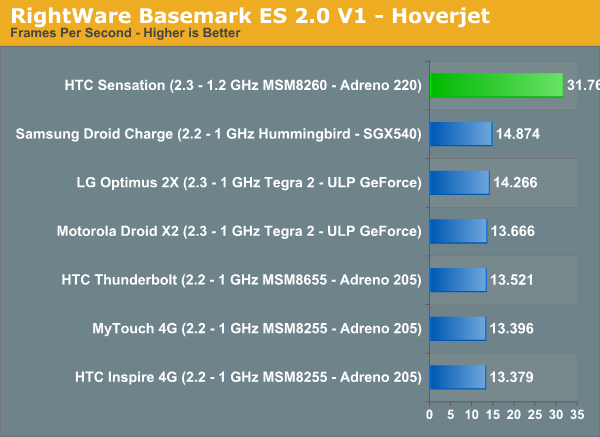
The Android port of Quake 3 is what we sort of started all of this mobile 3D benchmarking with, and we’re still running it even if it’s starting to hit vsync. The results look strange here until you realize that this is again running at native qHD resolution on the Sensation.
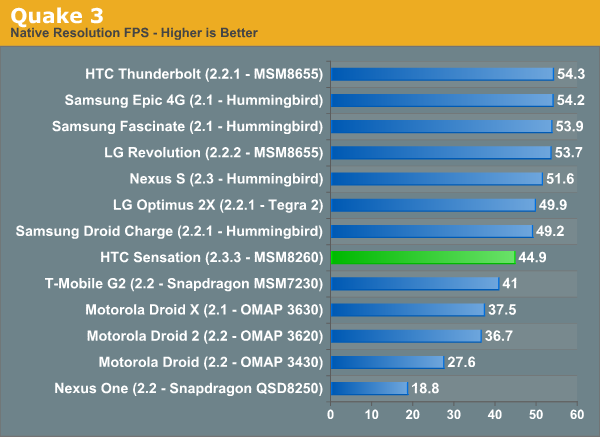
Next up is Linpack, which added a multi-threaded benchmark mode earlier this week. I’ve run it on all the dual core devices I could get my hands on. The initial multi-threaded version had some issues which were fixed on Tuesday, giving more accurate results. We’ll still run the single-threaded version alongside. The 20% jump in clocks shows itself nicely on the Sensation in single-threaded linpack compared to all those 1 GHz MSM8x55 phones we’ve tested.
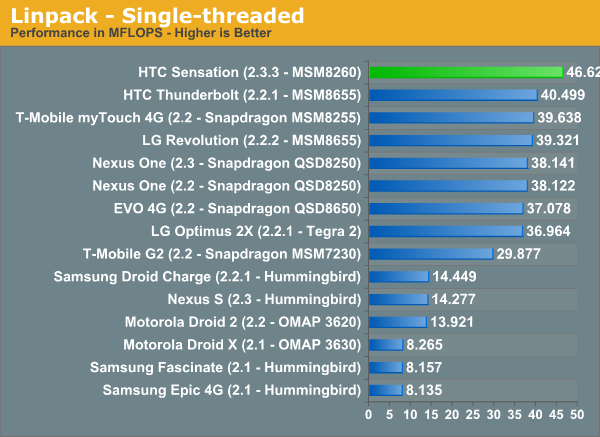
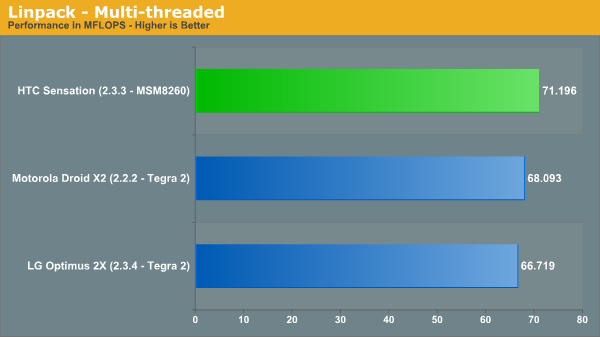
Last and most definitely least is Quadrant, which I think we've gone over our numerous reasons for disliking a few times. The tests themselves are starting to look seriously dated, including 3D tests which render improperly on Android 2.3 and are themselves up against the 60fps vsync cap through their respective runs. I'm sure that the rest of the poorly documented subtests are equally as subpar, however it's become something of a de-facto standard in certain circles.
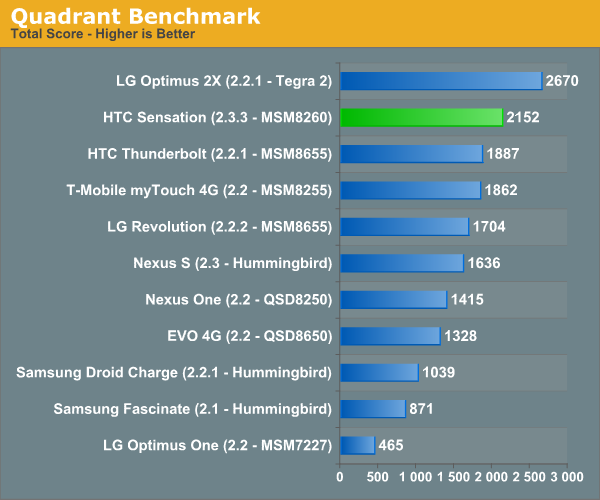
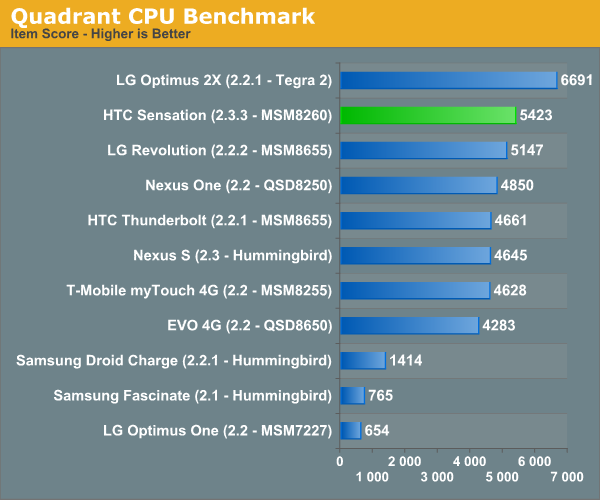
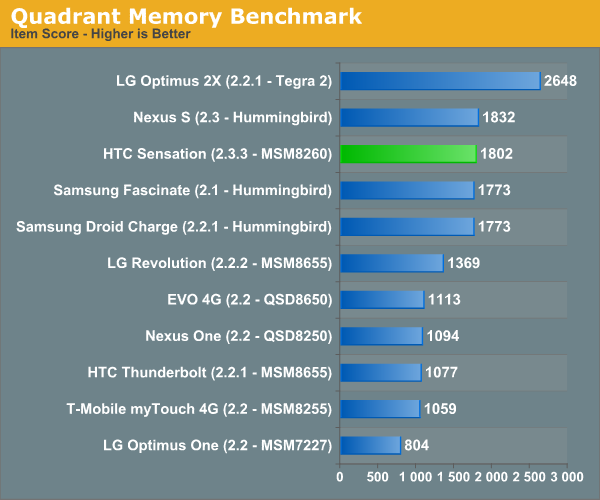
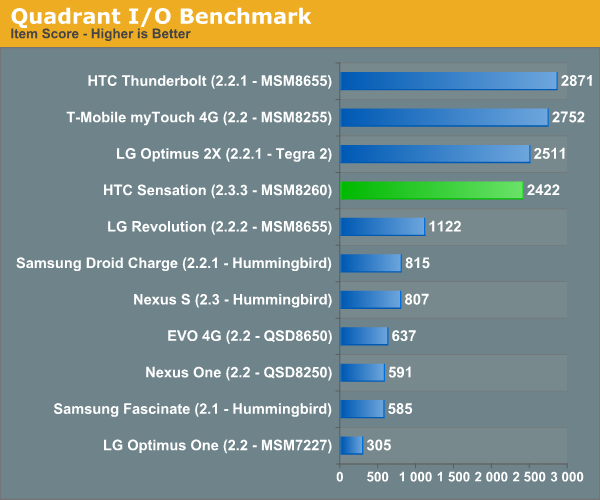
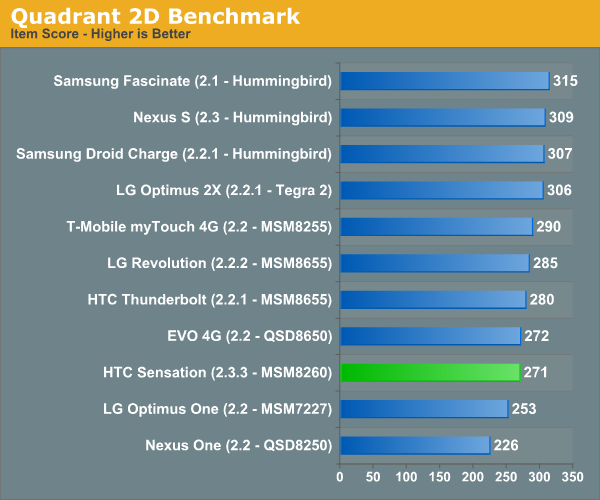
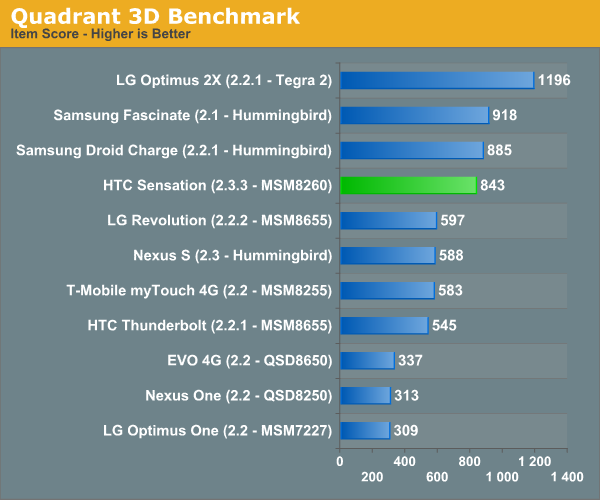
As an aside, I don't think we'll see Quadrant around for much longer, as there are better, more robust, fully documented tools by some established big names coming to the Android market (for free) shortly. All of those will probably quickly and thankfully replace Quadrant, as they all are gunning for its "go-to standard" status as the tool everyone runs, at least from the Android market. I have no doubt they'll quickly succeed.
The state of benchmarking on Android right now is a bit unbalanced, and what everyone wants is a system trace or general use benchmark that will show more than how the CPU does in synthetics and the GPU in synthetics. I fully expect all of that to change this calendar year. Just be patient.










107 Comments
View All Comments
Brian Klug - Friday, July 1, 2011 - link
We're still waiting for an SGS2, hopefully we will get one soon from Samsung USA and be able to compare it in its final form.Take care,
Brian
sam46 - Friday, July 1, 2011 - link
brian,this is one of the few reviews which have praised sensation.but in my view your review is the best.
i am saying this because i believe that unlike other reviewers you not only test mobile phones in your lab but also use them as in daytoday life as a normal user.this gives a better impression of the devices which you review.
many reviewers have given more praises to sgs2 than sensation.they have based their views with the limited time which they had with the devices that too in their testing labs.but i believe that in real world usage sensation makes more sense than sgs2.and this has happened before with their older brothers that is desire and sgs.the reviewers had given more praises to the sgs but the actual users prefered desire over sgs.
though samsung devices looks great on paper,users get frustated with their handsets.
apart from htc in my view hp makes better handsets.lately they are catching up with the hardware but their design sucks.for example take pre3,may be its design makes more sense while handling and using it,but its looks are not good enough to make a good impression.now that they are putting single core1.4ghz processor in pre3,but still they are behind the competition of dualcores.but i do believe that pre3 will give a tough competition to all the dual core phones in terms of speed and performance because of a very light os that is the webos. webos is unarguably the best os out there which is slick and fast,easy to use interface,better management of memory,provides true multitasking,provides a great
feature like just type, and a best notification system.webos is very very light when compare to ios and android,so i think it doesnt need a dual core processor and 1gb of ram.it can perform better than ios and android even with a single core processor and 512mb ram.but hp needs to work on better designs to give a better impression of their devices.
by the way,congratulations brian for this great article.pls tell me what do you think of the observations i made above.
StormyParis - Friday, July 1, 2011 - link
You need to be specific: what hidden drawbacks do Samsung's phones have ? and what hidden qualities, HTC's ?Disclaimer: my current HTC HD2 is the first phone I'm happy with in ages. I had junk from Motorola, LG, and Nokia before that had serious design flaws, plenty of bugs, bad support... or rather, all of the above. My HTC just worked from day one, now it's started a second life under CM7, and I'm very happy with it 2 yrs on.
I was looking foward to buying a Sensation. But the lighter weight, on the whole, better screen, and better moddability f the GS2 are on the verge of convincing me to buy that, instead.
sam46 - Friday, July 1, 2011 - link
Read the review of droid charge by brian klug.He clearly mentioned that samoled+ has some serious problems such as overheating,yellowish tint and oversaturated colours.It is the slimmest smartphone in the world,but according to many users sensation is better to handle.Due to its wait and built quality it feels solid in the hand.And also remember that sgs2 is made of plastic.To know what drawbacks samsung phones have you need to do some googling.Just search for
defects of sgs and sgs2.
bigboxes - Friday, July 1, 2011 - link
Please capitalize your sentences. It was quite the chore trying to read your post. If you want to be taken seriously you need to remember to correctly use those writing rules you learned in school.sam46 - Friday, July 1, 2011 - link
sorry,i am from a non english speaking country.despite that i can write pretty good english,isn't it?SimKill - Monday, July 4, 2011 - link
Do you still not capitalize stuff in your language? I'm a non-native English speaker too, and my language doesn't even have capital and small letters. I still make an effort to write well so that I can convey my message as clearly as possible.sam46 - Monday, July 4, 2011 - link
I will :)Speed3mon - Sunday, July 3, 2011 - link
bigboxes... gAyVisual - Friday, July 1, 2011 - link
Wait, what? Having white appear as red is accurate color now?BTW the Galaxy S II gives users a few choices of color calibration even with stock FW. And just wait and see what the hacked ones do...